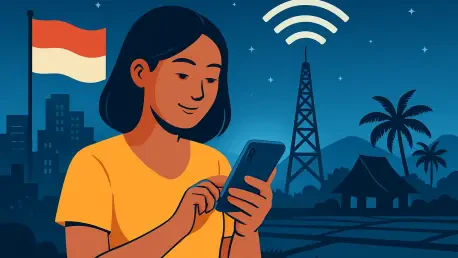In a sprawling archipelago of nearly 19,000 islands housing 280 million people, Indonesia grapples with unique geographical barriers that make digital connectivity a daunting challenge, especially when considering the diverse terrain and dispersed population. For the majority of its citizens, mobile networks serve as the primary conduit to the internet, positioning mobile performance as a pivotal element in shrinking the digital divide. This article delves into the impressive advancements Indonesia has achieved in bolstering mobile network infrastructure, enhancing internet speeds, and extending access across both bustling urban centers and far-flung rural regions. The journey toward digital inclusion is propelled by a dynamic mix of technological innovation and forward-thinking policies. With projections estimating the digital economy to soar to USD 2.8 trillion by 2040, the importance of mobile connectivity transcends mere utility—it has become a bedrock for economic expansion and social fairness. As mobile technology evolves, it is reshaping how Indonesians engage with education, commerce, and governance, offering a lifeline to communities once isolated by geography. The collaborative efforts between government bodies and private enterprises underscore a national resolve to ensure that digital opportunities are accessible to all, regardless of location or socioeconomic status. This exploration highlights the multifaceted strategies driving these changes, from widespread network upgrades to targeted technology rollouts, painting a picture of a nation determined to connect every corner of its vast landscape.
Accelerating Mobile Network Performance
Indonesia’s strides in mobile network performance stand as a cornerstone in its mission to close the digital gap that has long separated urban and rural communities. Recent data from Speedtest Intelligence® reveals a remarkable leap in median download speeds, climbing from a modest baseline to 30.5 Mbps by mid-2025, marking a nearly 70% improvement over three years. Upload speeds have also seen a notable boost, rising to 13.93 Mbps in the same timeframe, reflecting comprehensive upgrades in network capacity. This progress signals a robust infrastructure overhaul that prioritizes not just speed but also reliability, ensuring that users can engage in data-intensive activities like streaming and remote work with greater ease. Such enhancements are critical for a nation where mobile internet is often the only viable connection option, particularly in areas where fixed broadband remains impractical due to terrain or cost.
Equally significant is the impact on the slowest connections, typically found in remote and underserved regions. For the lower 10th percentile of users, download speeds have more than doubled, reaching 5.69 Mbps by mid-2025. This improvement is a testament to targeted efforts to extend the benefits of modern networks beyond metropolitan hubs, directly tackling the inequities that have historically plagued rural areas. It suggests that infrastructure investments are being channeled to uplift those most in need, fostering digital access for communities previously hindered by sluggish or nonexistent connections. This focus on the margins ensures that the digital divide is addressed at its roots, creating a more inclusive technological landscape across the archipelago.
Tackling Regional Connectivity Gaps
While urban powerhouses like Jakarta and Bali showcase top-tier mobile performance with median download speeds exceeding 41 Mbps in early 2025, the narrative of progress extends to even the most remote corners of Indonesia. North Maluku, often lagging behind in connectivity metrics, has witnessed a commendable rise in speeds, moving to 20.49 Mbps in the same period. This upward trend across diverse regions illustrates a national commitment to reducing disparities, ensuring that digital access isn’t a privilege reserved for city dwellers. The gains in speed are more than just numbers; they translate into tangible benefits like improved access to online education and telemedicine for populations once cut off from such services due to geographic isolation.
Further evidence of this inclusive approach is seen in areas like Gorontalo and the Bangka Belitung Islands, where the slowest connections have experienced substantial uplifts. In Gorontalo, speeds for the lower tier of users surged to 9.31 Mbps, while Bangka Belitung reached 7.91 Mbps by early 2025. These advancements highlight a deliberate strategy to prioritize regions that have historically struggled with connectivity, often due to challenging terrain or low population density. By focusing on these underserved areas, Indonesia is laying the groundwork for equitable growth, allowing rural economies to tap into digital markets and services. This regional focus is crucial for a nation with such a fragmented geography, ensuring that the digital revolution leaves no island or community behind.
Building a Strong 4G Foundation
The widespread expansion of 4G availability has emerged as a transformative force in Indonesia, where nearly 99% of internet users depend on mobile devices for access. By the first half of 2025, 4G coverage has exceeded 90% across all major islands, with Java leading at an impressive 96.4%. Even regions that historically trailed, such as Maluku and North Maluku, have reached 90.1%, marking a significant milestone in nationwide connectivity. This extensive reach is vital for enabling access to digital tools and services, from online learning platforms to e-commerce, for millions of Indonesians regardless of their location. The near-universal presence of 4G networks serves as a foundation for bridging gaps in access, ensuring that basic internet functionality is no longer a luxury but a standard expectation.
Beyond the headline figures, the impact of 4G expansion is particularly profound in rural and frontier areas, often referred to as the 3T regions—terdepan, terluar, tertinggal (frontier, outermost, and underdeveloped). The push to bring high-speed mobile internet to these zones has opened doors to economic opportunities previously out of reach, such as mobile banking and remote job opportunities. Infrastructure developments in these areas are not just about connectivity but about empowerment, allowing small businesses and farmers to connect with broader markets. This strategic emphasis on 4G as the backbone of mobile access underscores a pragmatic approach to digital inclusion, prioritizing widespread coverage over newer, less accessible technologies in regions where basic connectivity remains the primary need.
Strategizing 5G Deployment for Future Growth
Unlike the broad sweep of 4G expansion, the rollout of 5G technology in Indonesia follows a more measured and selective path, focusing primarily on urban and high-demand areas. Bali and Nusa Tenggara have taken the lead, achieving 17% 5G availability by early 2025, a sharp rise from just 4.4% a year prior. In contrast, regions like Java and Sumatra show slower adoption at 6.5% and 4.8%, respectively, while remote areas such as Kalimantan and Papua remain largely untouched due to hurdles like limited mid-band spectrum and steep infrastructure costs. This urban-centric strategy reflects a practical balance between immediate connectivity needs and the long-term vision of integrating cutting-edge technology in areas with the density and demand to justify the investment.
The cautious pace of 5G deployment also highlights the complexities of scaling such advanced networks in a geographically fragmented nation. While urban centers benefit from faster data speeds and lower latency—key for innovations like smart cities and industrial automation—rural regions face economic and technical barriers that delay similar upgrades. This disparity is not an oversight but a deliberate prioritization, ensuring that resources are allocated where they can deliver immediate impact while planning for eventual broader coverage. As spectrum availability improves and costs decline, the expectation is that 5G will gradually extend to less populated areas, building on the robust 4G base to create a seamless transition to next-generation connectivity across the archipelago.
Fostering Collaboration Through Public-Private Efforts
A critical driver behind Indonesia’s mobile connectivity gains is the synergy between governmental initiatives and private sector innovation. The Ministry of Communication and Digital Affairs (KOMDIGI) has set an ambitious tone with the Digital Indonesia Roadmap, focusing on infrastructure development in remote and underserved areas. Programs like the Universal Service Obligation (USO) fund, alongside landmark projects such as the Palapa Ring fiber optic network and the SATRIA-1 satellite, are instrumental in extending internet access to regions where commercial viability is low. These efforts target the 3T areas, ensuring that even the most isolated communities are integrated into the digital fold through sustainable and scalable solutions.
Complementing these public initiatives are the substantial contributions of major mobile operators like Telkomsel and Indosat Ooredoo Hutchison. Telkomsel has established over 2,100 5G sites across 56 cities, spearheading the adoption of advanced technology in urban zones. Meanwhile, Indosat employs network-sharing models to accelerate its 5G expansion efficiently. Additionally, the construction of over 6,000 Base Transceiver Stations (BTS) for 4G in less-served regions demonstrates how public-private partnerships can address logistical and financial challenges. This collaborative framework ensures that both immediate connectivity needs and future technological aspirations are met, creating a balanced ecosystem where policy and private investment work hand in hand to narrow the digital divide.
Envisioning a Digitally Inclusive Future
Reflecting on Indonesia’s journey, the mobile network advancements achieved in recent years have laid a solid foundation for reducing the digital divide, driven by impressive gains in speed, extensive 4G coverage, and strategic 5G implementation. Public-private collaborations have proven essential in overcoming the nation’s geographic and economic hurdles, ensuring connectivity reaches even the most remote areas through targeted infrastructure projects. These efforts have reshaped access to digital resources, empowering communities with tools for education, business, and social engagement that were once out of reach.
Looking ahead, the focus should shift toward sustaining this momentum by addressing lingering challenges such as spectrum limitations for 5G and the high costs of rural infrastructure. Expanding funding mechanisms like the USO fund and fostering innovation in cost-effective technologies could accelerate progress. Additionally, continuous monitoring of regional disparities will be crucial to maintain equity in access. As Indonesia builds on these past successes, the path forward involves not just maintaining current gains but also anticipating future needs, ensuring that every citizen, from urban centers to frontier islands, remains connected in an increasingly digital world.









